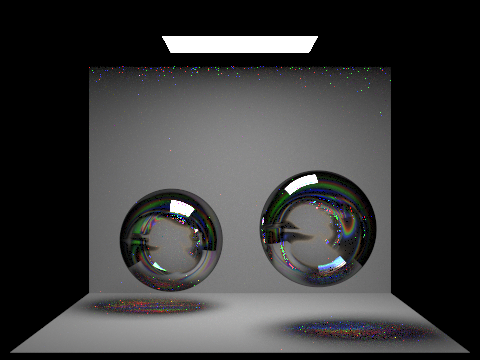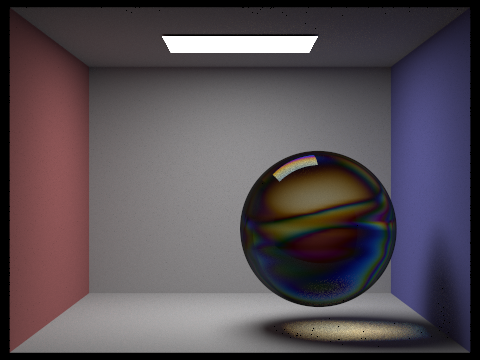Thin Film BSDF
The spectral ray tracing capability developed herein relies on a thin-film BSDF subclass that we have implemented for our project. Upon ray intersection with a thin film object, this BSDF queries the thickness of the bubble at the intersection point from a thickness map computed by the fluid simulator. After conducting bilinear interpolation over the nearest tabulated thickness values, the methods in this subclass compute the effects of thin-film interference and supply proper weights to each RGB channel in the backtraced ray. Additionally, to assign this specialized BSDF to objects in the scene we modified the COLLADA parser to handle creating instances of this subclass using the supplied thin film data.

Physics-based TFI:
- To associate color with the thin film interference effect, we sparsely sample the visible spectrum using three wavelengths $$ \lambda = 614nm, 549nm, 466nm $$. The thin film reflection coefficients computed for each of these wavelengths are taken to be the proportion of red, green, and blue respectively.
- Sparse sampling of the visible spectrum (3 wavelengths) turned out to be insufficient under the physics-based thin film interference scheme that we set out to implement at the beginning of the project.
- Response curves for the reflections coefficients are sharply peaked so we see only narrow bands of red, green, and blue in the initial renders (see below).

|

|
- We forgo the need for denser spectral sampling by implementing a pseudo-physical TFI approach originally developed for shader programs.
- In this alternative method the reflection coefficient linked to each color channel reweights the Schlick approximation of the Fresnel Factor for each color channel. Formally, $$R_\lambda = w_\lambda \cdot R_s$$ where $$w_\lambda = \frac{ 1 + \cos(\phi_\lambda)}{2} \hspace{2cm} \text{ and } \hspace{2cm} \phi_\lambda = 2\pi \frac{n \cdot t}{\lambda \cdot \cos(\theta_i)}$$

|

|